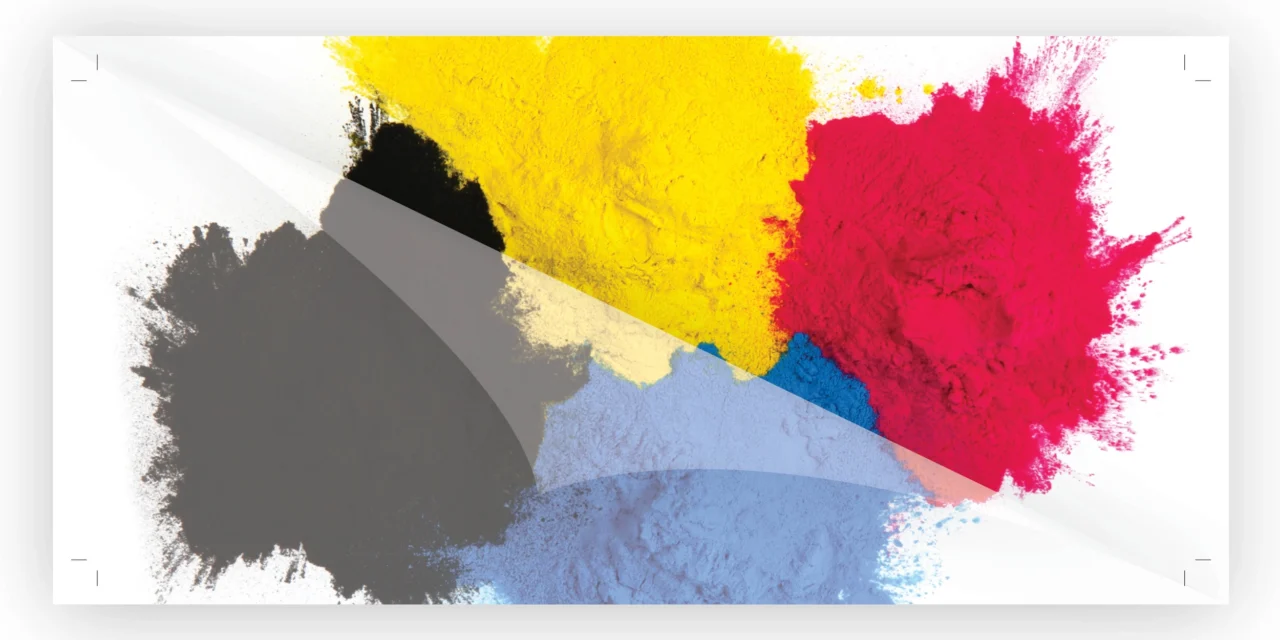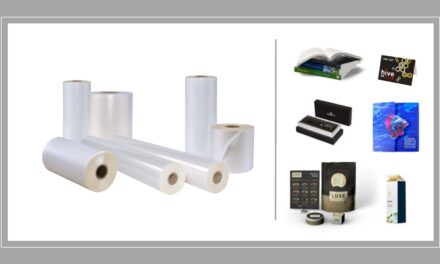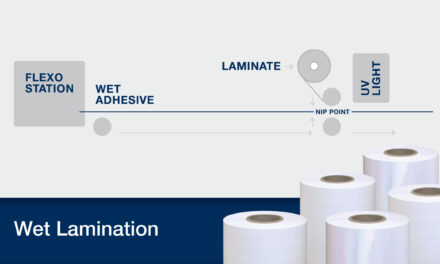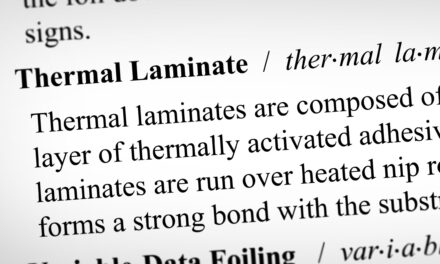THE RISING POPULARITY OF DIGITAL PRINTING
As digital printing technology becomes more advanced, print service providers across the print and packaging industry are increasingly integrating digital presses into their workflows. Digital presses simplify pre-press, allow printers to take on smaller volumes with higher margins, and lower the barrier to entry, encouraging newcomers to try their hand at creating innovative solutions for brands in a variety of markets.
However, the inks used in digital presses have historically had a reputation of being challenging to use in conjunction with thermal lamination and several other post-print processes. Although this rule is no longer so black and white as it was in years prior, it can still be difficult for printers to know what thermal laminates and post-laminate processes are compatible with the ink they are using.
In this post, we will look at why some digital inks can pose a challenge in thermal lamination, identify some manufacturers whose digital inks are more compatible with standard thermal laminating options, and cover a few tips and tricks for how printers can better guarantee success when it comes to thermally laminating digital prints that make use of challenging ink types.
Why Are Some Digital Inks Challenging to Laminate?
It should come as no surprise that offset presses and digital presses are fundamentally different in the way that they function. Unlike a conventional press, which uses specially made plates to transfer ink onto the substrate, the vast majority of digital presses apply ink directly to the paper (although there are exceptions to this rule). Digital inks are specifically designed to run smoothly through the components of a digital press and print cleanly onto paper and other substrates.
To get the most high-quality results, digital press manufacturers have historically utilized dry toner in their inks, giving them a waxy quality that prevents them from adhering well to the thermal adhesives typically used on laminates. These inks were designed to optimize the printing process, so compatibility with lamination and other post-press processes was not considered a priority in their development. Instead, the print finishing industry responded with more specialized products that were able to adapt to these challenging digital inks.
Today, many digital press manufacturers still utilize ink formulas that are not compatible with the standard EVA adhesive options on most thermal laminates, but this old rule of thumb has become much less accurate than in previous years.
CHANGING TRENDS IN DIGITAL INK
As digital printing has become a staple in the print and packaging industry and grown more competitive with offset processes in a variety of markets, digital press manufacturers have fine-tuned their inks and consistently improved upon old formulas. While enhanced compatibility with standard EVA adhesives was not the primary goal in these adjustments, it is fortunate for printers, suppliers, and brands alike that newer ink formulas are much more likely to adhere to the average thermal laminate. With these new inks, printers are not limited to specialized laminates and can instead access a much wider range of finishes and laminate types.
Digital Inks Compatible With Standard Adhesives
Next, we will look at a few of the most popular digital press manufacturers in the industry and examine how compatible their inks are with standard thermal laminates.
HP Indigo
HP set the stage for other digital press manufacturers when the company began utilizing electrostatic ink for their HP Indigo presses. These inks still include toner powder, but the powder is suspended in imaging oil, preventing it from directly touching the adhesive and enabling the average thermal laminate to form a strong bond.
This compatibility has made HP Indigo a leading press manufacturer for print service providers who utilize thermal lamination. In fact, HP Indigo ink is so important to the thermal lamination space that Nobelus has long been an official HP partner, allowing both companies to work together in researching and developing innovative new solutions that can better meet the needs of digital print service providers.
Canon Presses
Canon VarioPRINT i/iX-series digital presses utilize aqueous (or water-based) inkjet and are overwhelmingly compatible with standard thermal adhesives. Much like HP Indigo, Canon V1000 presses use electrostatic ink, making them highly receptive to most thermal laminates. The Canon ImagePRESS series uses T01 and T02 toner, both of which are compatible with standard thermal laminates. For units outside this list, Nobelus recommends testing ink/laminate compatibility before purchasing a thermal laminate.
Fujifilm
Like several Canon presses, the Fujifilm JPress digital press uses aqueous inkjet and has reliably proven to work with most thermal laminates. Other Fujifilm equipment may use different inks, and we recommend testing before a live run.
Other Manufacturers
Many manufacturers use inks that have shown compatibility with standard adhesives in certain contexts, but the solutions experts at Nobelus would not recommend purchasing laminates for a live run on these presses without testing them first. Xerox, for instance, has a few digital inks that have, in specific instances, worked well with normal adhesives. However, we always recommend sending in sheets for testing when the press being used is manufactured by one of the following companies:
- Kodak
- Komori
- Konica
- Ricoh
- Xeikon
- Xerox
While these digital presses do not have the same consistency and reliability as the listed HP, Canon, or Fujifilm systems, there is always a chance that they will work in conjunction with standard adhesives. Many variables, from humidity and run speed to elevation and time of year, can affect how well thermal adhesives work with a given digital ink, so it is always worth testing.
NOBELUS LAMINATES FOR CHALLENGING DIGITAL PRINTS
If testing shows that your ink type does not accept standard adhesives, do not get discouraged. Nobelus and many other thermal laminate suppliers have addressed this market need by offering products with more aggressive adhesives that can form a strong bond with even the most challenging digital inks.
While some of these laminates may come at a higher cost due to being specialty items, this does not hold true across the board. Some of the following laminates are specifically designed to meet the needs of the digital market, but others are compatible due simply to the way they were manufactured. As mentioned previously, Nobelus always recommends printers order a sample roll of any product they are interested in before placing an order for a live job.
DigiBOND™ Laminates
As the name implies, DigiBOND adhesive was developed specifically to accommodate even the most challenging digital inks. This extremely strong adhesive formula is the safest choice for a printer who does not have time to validate ink/laminate compatibility, although some of the laminates in this line can cost as much as 20% – 30% more than their standard adhesive counterparts depending on the product. We also do not recommend DigiBOND laminates for HP Indigo presses as they may peel the ink away from the substrate.
- PlatinumPET™ Gloss Laminates With DigiBOND: These PET laminates are incredibly durable and come in a wide range of thicknesses to meet the needs of many different applications. This product line is ideal for digital printers who want to perform double-sided lamination and have finishing equipment with hot knife or flying knife separation.
- Karess® Printable Laminate With DigiBOND: This incredibly soft premium laminate is not only printable, enabling printers to layer effects and embellishments, but it also serves as an example of a DigiBOND laminate that is less expensive than its standard adhesive iteration. In fact, this BOPP laminate is so popular with digital printers that it has become the standard in the industry segment. Karess gives prints a matte look while forming an instant connection with consumers through its luxurious rose-petal texture.
- ScuffProof® Laminate With DigiBOND: Completely resistant to scuffing, scratching, and burnishing, ScuffProof Laminate provides complete protection to prints while giving them a subtle matte appeal. This BOPP laminate is compatible with bursting separation and suits a broad range of reusable packaging applications.
FineLinen™ Laminate
Part of the Nobelus Tactile Collection, FineLinen Laminate is not categorized as being strictly for challenging digital inks. However, it is manufactured with a strong adhesive that enables it to adhere to most inks. This BOPP laminate features an elegant linen pattern that makes it perfect for applications like wedding invitations, business cards, and specialty stationery.
FineLeather™ Laminate
Like the previous product, FineLeather Laminate is part of the Nobelus Tactile Collection. Its faux leather pattern is ideal for themed marketing strategies, and it can be used for menus, folding cartons, business cards, and a wide variety of other applications. It is made of BOPP and can be used on equipment with bursting separation.
PlatinumSHR™ 1.6 mil Gloss Laminate
PlatinumSHR Laminate is designed for digital photo production, but its unique properties make it useful for many other applications, as well. This laminate is made of BOPP, and while it comes in a crystal-clear gloss finish, it is designed to be embossed in order to replicate the look of conventional silver halide photographs. It is ideal for any printers who use challenging digital inks and offer embossing as a value-add post-laminate effect.
Other Tips for Laminating Digital Inks
Purchasing a specific laminate is not the only option available to digital printers. The following tips may require a larger initial investment or adjustments to workflow, but they are valid solutions for digital printers who want to access the full range of laminating options available to conventional printers.
- IR Heater: Adding an IR heating system to a thermal laminator enables the machine to evaporate certain components of the digital ink that prevent adhesion, making even challenging ink types more compatible with standard thermal adhesives. These units are a fraction of a percentage of the total cost of a thermal laminator, but they can help printers save money in the long run.
- Wait Between Steps: While this solution is not popular as every second counts on the production floor, waiting at least half a shift or even a whole shift before running digital prints through the laminator will vastly increase the likelihood of a standard thermal laminate adhering to digital inks. Likewise, waiting to perform post-laminate processes that interfere with the adhesive, such as die cutting, folding, and scoring, can greatly improve the final product. If a production manager can organize a system that allows for such pauses in production, the business will likely save money on material costs and flawed prints.
LET NOBELUS TEST YOUR DIGITAL APPLICATION
Whether you have a press that has been validated to accept standard laminates or are concerned that your digital ink type might require a specialty product, the solutions experts at Nobelus are always eager to get in touch and find the solution that is right for your business. We offer in-house testing for all our thermal laminate customers and can personally verify if a standard laminate is compatible with your specific application. Each test includes formal documentation for every datapoint our internal team tested and detailed guidance and suggestions on how to move forward. Let us share our knowledge and resources to help your business meet its goals.





